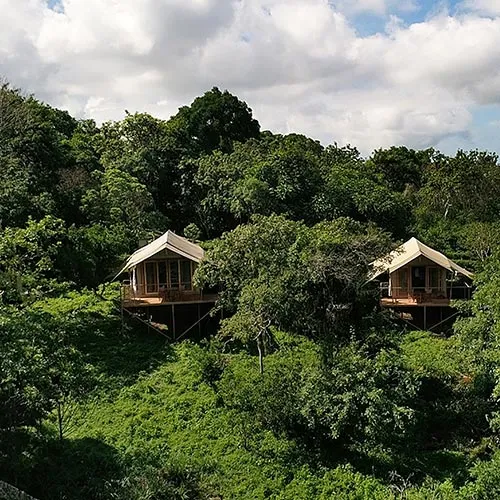Prepare for your Galapagos vacation with some of the many fantastic guidebooks written by passionate experts: books that help you identify the wildlife, understand how the islands were formed, and how best to navigate them.
But beyond the history and science, these strange volcanic landscapes have proved fertile ground for remarkable human stories: of adventure, of tragedy, and of romance. Whether you want to learn about the species ahead of your trip or come equipped with an inspiring poolside read, there’s a Galapagos book for everyone.

Wildlife and Identification Guides
Wildlife of the Galapagos (Traveller’s Guide)
by Julian Fitter, Daniel Fitter & David Hoskins
A handy identification guide to the wildlife of the Galapagos, this book lists and provides insight into more than 350 of the creatures that you might encounter over your adventure. There are also beautiful photographs, maps and drawings as well as information about visitors’ sites and local facts.
Recommended by one of our naturalist park guides.
Galapagos Wildlife, a Visitor’s Guide
by David Horwell and Pete Oxford
Authors David Horwell and Pete Oxford are passionate expert naturalists who fell wildly in love with Galapagos. Their book is packed with vivid descriptions, entertaining anecdotes and wildlife identification tips. Unique island trail plans are a useful addition for any explorer.
Flowering Plants of the Galapagos
by Conley K. McMullen
The ultimate botanical reference book for the Galapagos Islands, this compact guide is the fruit of the author’s 16 years of fieldwork on the archipelago. It’s clearly written and accessible, fascinating for flora beginners and experts alike, allowing the easy identification of more than 436 flowering plants.
Marine Mammals of the World, Second Edition: A Comprehensive Guide to Their Identification
by Thomas A. Jefferson and Marc A. Webber
With descriptions and illustrations, this is one of the most comprehensive marine guides in the world. Advances in digital, underwater and autofocusing photography allow the authors to make it more attuned to the research-focused needs of biologists and enthusiasts alike, giving great insight into all the oceanic beasts you will encounter on your Galapagos voyage.
DK Smithsonian’s Handbook to Whales, Dolphins and Porpoises
by Mark Carwardine and Martin Camm
Delightfully presented in a textbook style, this DK guide is characterized by its authoritative text and 900, detailed illustrations. It makes identifying Galapagos sea creatures a breeze, allowing readers to understand more about the wonderful beasts they see before them.
Galapagos Diary, a Complete Guide to the Archipelago’s Birdlife
by Hermann Heinzel and Barnaby Hall
This beautifully illustrated book is the perfect companion for bird enthusiasts, with the habitats and breeding strategies of each of the islands’ birds detailed and explained. It also includes a field guide with sketches, paintings and maps.
Wildlife of Ecuador: A Photographic Field Guide to Birds, Mammals, Reptiles, and Amphibians (Princeton University Press) Wild Guides
by Andres Vasquez Noboa and Pablo Cervantes Daza
A go-to, all-in-one-guide for the Ecuador wildlife enthusiast, this book is handy for those on a wildlife odyssey around one of the most biodiverse countries on the planet. It covers more than 350 birds, mammals and amphibians, providing excellent insight into their identification and behaviors. There are also hundreds of photos, maps and diagrams for easy use.
Memoirs and Real Life Stories
My Father’s Island: A Galapagos Quest
by Johanna Angermeyer
Reading more like a novel than a true-to-life memoir, this tale follows the author in her search for her romantic family history, a family who were among the first settlers on the Galapagos Islands. With shipwrecks, daring pilots, madness and heartbreak, My Father’s Island is a holiday read that brings color and life to a Galapagos adventure.
The Voyage of the Beagle
by Charles Darwin
Originally published in 1839, The Voyage of the Beagle is the classic account of Charles Darwin’s oceanic odyssey that brought him to the Galapagos Islands and led to the beginnings of his ground-breaking evolutionary theory. Discover the archipelago through the young explorer’s eyes, including encounters with marine iguanas, giant tortoises and finches.
The Enchanted Islands: The Galapagos Discovered
by John Hickman
John Hickman delves deep through the history of the islands to the Inca times, introducing a troupe of engrossing characters including conquistadors, buccaneers, pirates, mad explorers, opportunist colonists and devout naturalists. The most famous of all of these was Charles Darwin.
In the Galapagos Islands with Herman Melville, The Encantadas, Or Enchanted Islands
by Herman Melville
History and legend, fiction and fact, myth and mystery swirl and combine like the great Galapagos ocean currents in this account by one of North America’s most acclaimed writers. The Moby-Dick author brings this exotic land to life with tales of Spanish explorers and American whalers – like himself, who came to the archipelago on the whaler Acushnet. The book includes his original illustrations.
The Galapagos Affair
by John E Treherne
Juicier than any erotic thriller, this work of nonfiction unravels the incredible tales circulating around the islands in the middle of the last century. Accounts of nudism and free-love communes abounded, though something even more exotic was afoot: the self-styled Baroness Wagner-Bosquet and her trio of young, male lovers who she kept in line with a riding crop, pearl-handled revolver and greedy sexual appetite. When she disappeared and unidentified bodies appeared on a nearby island, more questions, and more mysteries, came to light.
Natural History Books
Galapagos: A Natural History Guide (Odyssey Natural History Guide)
by Pierre Constant
This comprehensive, nonfiction guide takes a deep dive into the human history, geology and origin of the Galapagos Islands, particularly the fascinating lives of the residents and how they are affected by weather phenomena. The accompanying photography is stunning.
Galapagos, a Natural History
by Michael H. Jackson
This accessible guide details the management and conservation of the Galapagos National Park as well as the practical visitor and site information. The index and checklist of plants and animals is a fun way to keep track of your discoveries.
Galapagos: The Islands That Changed the World
by Paul D. Stewart and Richard Dawkins
This book puzzles over how such a fantastic array of life has come to thrive in the unruly environment of the Galapagos Islands. Digging down into how micro-climates and altitude have formed and shaped this unlikely world, Galapagos: The Islands That Changed the World leaves you with a sense of wonder and excitement for your Galapagos journey.
The Galapagos: A Natural History
by Henry Nicholls
Science writer Henry Nicholls paints a colorful picture of the natural and human history of the Galapagos Islands, exploring their fiery and explosive origins as well as their surreal landscapes, strange flora, and spectacular wildlife. The author’s own experiences of the islands naturally weave their way through explanations of the conservation efforts at work and the wide-reaching consequences of everything that happens here.
The Galapagos: Exploring Darwin’s Tapestry
by John Hess
Ornithologist and evolutionary ecologist John Hess celebrates the wildlife hotspot that inspired Charles Darwin, throwing the doors open to a land that once only the very few could encounter. Intimate photo essays accompany in-depth descriptions of various Galapagos denizens, creatures like the flightless cormorant, marine iguana and Galapagos tortoise presented by Hess as Galapagos Royalty. More than a place of scientific interest, Hess captures a land of child-like awe.
Biology and Evolutionary Science
Lonesome George: The Life and Loves of a Conservation Icon
by Dr. Henry Nicholls
Never has a tortoise been more marveled at, more visited, or more baffling than Lonesome George, the 5ft long giant tortoise who might have been the last of his Pinta island subspecies. Dr. Henry Nicholls recounts the great lengths that conservationists have gone to preserve this great icon’s habitat, the controversies raging around him, and the beautiful Swiss graduate who dedicated four months to trying to convince George to have sex. Though George died in 2012, this account is as relevant and heart-warming as ever.
The Beak of the Finch: A Story of Evolution in Our Time
by Jonathan Weiner
If you thought that the process of evolution had come to a close, or that it takes millions of years to manifest itself, this book will prove otherwise. It follows the studies of two Princeton University scientists – evolutionary biologists – engaged in an extraordinary investigation. Peter and Rosemary Grant have watched evolution in finches happening in real time, documenting for 20 years the changes that they have witnessed – and the ramifications these have for the rest of the planet.
Galapagos: Preserving Darwin’s Legacy
by Tui de Roy
A book billed “remarkable” by BBC Wildlife and “spectacular” by Seabird combines the stunning photography of renowned photographer and long-term Galapagos resident Tui de Roy with insightful essays on the marine environment, unique vegetation, and scientific developments. A sumptuous coffee-table-style book, this is a treasure and keepsake to remind you of your trip to the Enchanted Islands.
Galapagos at the Crossroads: Pirates, Biologists, Tourists and Creationists Battle for Darwin’s Cradle of Evolution
by Carol Ann Bassett
This provocative account examines the human impact on the Galapagos Islands: the steep increase in residents, invasive species, a flood of tourists and the tense conflicts between the Ecuadorian government and Galapagos conservationists. Explaining why Galapagos was recently added to UNESCO’s World Heritage in Danger list, Bassett leaves her readers with a distinct sense of what is at stake.
A Modest Genius: The Story of Darwin’s Life and How his Ideas Changed Everything
by Hanne Strager and Sarah Darwin
Combining a biography of Charles Darwin with clear explanations of popular science, this is a juicy account of the great scientist’s life and the events that would lead to his world-changing theory. Strager manages to gives new perspectives on Darwin’s life and adds new scientific information that post-dates his theory, without assuming deep scientific knowledge on the readers’ part, making this a great accompaniment to a budding biologist.
40 Years of Evolution: Darwin’s Finches and Daphne Major Island
by Peter R. Grant and B. Rosemary Grant
These landmark studies pick up from where Charles Darwin left off, detailing the evolutionary behavior of finches on the Galapagos island of Daphne Major. Richly illustrated, the book is filled with the authors’ astute research and observations of how they relate to the world today, detailing the range of ecological, behavioral, and genetic data – including song recordings and DNA analyses – that led them to their fascinating conclusions.
Evolution in Action: Natural History Through Spectacular Skeletons
by Jean-Baptiste De Panafieu
Gain a deeper understanding of the mechanics of evolution through this beautiful collection of photographs of fossils, undeniable clues as to the secrets of all life.
Plan your Galapagos Vacation!
See our Safaris for suggested Galapagos itineraries and recommended activities.
You Might Also Be Interested In:
See below more resources for planning a trip to the Galapagos Islands.
Educational Resources for Kids Visiting the Galapagos
Recommended Galapagos Packing List
